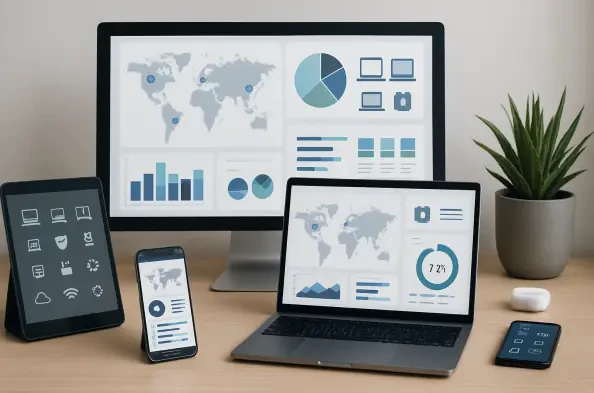In today’s fast-paced digital landscape, where businesses grapple with an ever-expanding array of devices and cyber threats, endpoint management software stands as a vital shield for organizational security and efficiency. As hybrid and remote work models continue to dominate, the necessity to oversee laptops, smartphones, tablets, and other connected hardware has reached unprecedented levels. With endpoints often serving as the most vulnerable entry points for cyberattacks, companies face mounting pressure to deploy robust tools that not only secure these devices but also streamline IT operations. The growing complexity of IT environments, fueled by Bring Your Own Device (BYOD) policies and diverse operating systems, demands solutions that balance versatility with user-friendly design. This article delves into the leading endpoint management platforms available now, offering a detailed evaluation of their features, scalability, and alignment with specific business needs. By exploring ten standout solutions, from Microsoft Intune to ManageEngine Endpoint Central, a clear picture emerges of how these tools address modern challenges. The focus remains on critical aspects such as security, automation, and cloud-based capabilities, ensuring businesses can navigate the intricate demands of device management with confidence. Ultimately, the goal is to provide actionable insights for selecting a platform that best fits unique organizational priorities, whether for a small startup or a global enterprise.
Key Themes in Endpoint Management Software Today
Security as the Top Priority
The foundation of any effective endpoint management solution lies in its ability to safeguard devices against the increasingly sophisticated landscape of cyber threats, a concern that has escalated with the proliferation of remote work setups. Every major platform prioritizes security through features like real-time threat detection, automated patch management, and compliance enforcement. Microsoft Intune, for instance, integrates seamlessly with Microsoft Defender to offer robust protection, ensuring vulnerabilities are addressed swiftly across a network. Similarly, Citrix Endpoint Management provides advanced encryption and micro-VPN options, catering to businesses needing secure remote access for distributed teams. These capabilities are no longer optional but essential, as endpoints remain prime targets for data breaches. The emphasis on security reflects a broader industry acknowledgment that unprotected devices can lead to significant financial and reputational damage, making it a non-negotiable criterion for software selection.
Beyond the core protective measures, many solutions are enhancing their security frameworks with proactive strategies to stay ahead of emerging risks. Platforms are increasingly embedding features like behavioral analysis and anomaly detection to identify potential threats before they materialize into full-scale attacks. Ivanti Neurons for UEM, for example, uses AI-driven insights to predict and remediate issues, reducing the window of exposure for endpoints. This shift toward anticipatory security underscores the need for tools that not only react to incidents but also prevent them. For businesses operating in regulated industries such as healthcare or finance, where data breaches can result in hefty penalties, these advanced security layers provide a critical safety net. The focus on compliance, through detailed reporting and automated policy enforcement, further ensures that organizations can meet stringent standards without overwhelming IT resources.
Cross-Platform Compatibility and Automation
Managing a heterogeneous mix of devices has become a defining challenge for modern IT teams, especially as employees use a combination of corporate and personal hardware across multiple operating systems. Cross-platform compatibility stands as a pivotal feature in endpoint management software, with solutions like Ivanti Neurons for UEM and Workspace ONE UEM excelling in supporting Windows, macOS, iOS, Android, and even Linux in some cases. This versatility allows businesses to consolidate management under a single console, simplifying oversight of diverse device fleets. The ability to handle BYOD policies without compromising security is particularly valuable, as it accommodates employee preferences while maintaining strict access controls. Such comprehensive support reduces the risk of shadow IT, where unmanaged devices can create hidden vulnerabilities, and ensures a cohesive strategy for device governance.
Automation, meanwhile, has emerged as a transformative element in reducing the burden on IT staff, who often face repetitive and time-consuming tasks in large-scale environments. Features such as automated device enrollment, patch deployment, and compliance checks are now standard across top platforms, enhancing operational efficiency. NinjaOne, for instance, streamlines routine processes with an intuitive interface, allowing IT teams to focus on strategic priorities rather than manual interventions. This capability not only boosts productivity but also minimizes human error, a common factor in security lapses. As businesses scale, the ability to automate at every level—from initial setup to ongoing maintenance—becomes a deciding factor in selecting a solution. Automation’s role in maintaining endpoint health without constant oversight positions it as a cornerstone of modern IT management, particularly for organizations with limited resources.
Emerging Trends Shaping the Future
Integration of Advanced Technologies
The incorporation of cutting-edge technologies such as artificial intelligence (AI) and zero-trust security models marks a significant evolution in endpoint management software, reflecting a shift toward proactive rather than reactive strategies. AI-driven tools, exemplified by Ivanti Neurons for UEM, enable predictive issue resolution by analyzing patterns and identifying potential problems before they disrupt operations. This forward-thinking approach helps businesses stay ahead of threats, minimizing downtime and enhancing overall resilience. Zero-trust security, prominently featured in Workspace ONE UEM, enforces strict access controls by assuming no user or device is inherently trustworthy, thereby reducing the risk of insider threats or compromised endpoints. These innovations signal an industry-wide recognition that traditional security measures alone are insufficient against today’s complex cyber landscape, pushing vendors to embed smarter, more adaptive technologies.
Beyond AI and zero-trust frameworks, the adoption of machine learning and advanced analytics is further refining how endpoint management tools operate, offering deeper insights into device health and user behavior. SolarWinds Endpoint Central, for instance, leverages analytics to provide detailed visibility into network performance, allowing IT teams to make data-driven decisions. Such capabilities empower organizations to optimize resource allocation and address vulnerabilities with precision. The integration of these technologies also supports scalability, ensuring that as businesses grow, their endpoint solutions can handle increased complexity without performance trade-offs. This trend toward intelligent, data-centric management highlights a broader movement in IT toward automation and foresight, positioning companies to tackle future challenges with greater confidence and efficiency.
Convergence with Digital Workspaces
Endpoint management is no longer just about controlling devices; it increasingly intersects with broader digital workspace solutions to create secure, productive environments for remote and hybrid workforces. Platforms like Workspace ONE UEM and Citrix Endpoint Management are at the forefront of this convergence, offering integrated features for application delivery, secure access, and user experience optimization. By combining endpoint oversight with tools that facilitate collaboration and productivity, these solutions address the holistic needs of distributed teams. This approach ensures that employees can access necessary resources from any location without compromising security, a critical factor as remote work remains a staple of modern business operations. The seamless blending of management and workspace functionalities reflects a growing demand for unified platforms that simplify IT while enhancing employee satisfaction.
This trend also underscores the importance of user-centric design in endpoint management, as businesses seek to minimize friction for both IT administrators and end-users during daily operations. Tools that prioritize intuitive interfaces and zero-touch deployment, such as those seen in Jamf Pro for Apple devices, reduce onboarding times and technical hurdles, fostering adoption across organizations. The focus on digital workspaces extends to supporting diverse use cases, from enabling secure access for contractors to ensuring compliance for full-time staff in regulated sectors. As companies continue to navigate the complexities of hybrid models, the ability of endpoint solutions to integrate with broader ecosystems—such as cloud services and identity management systems—becomes a defining competitive advantage. This convergence is reshaping expectations, pushing vendors to deliver comprehensive tools that go beyond traditional device management.
Choosing the Right Tool for Your Needs
Scalability and Target Audience
Selecting an endpoint management solution that aligns with a business’s size and growth trajectory is paramount, as scalability directly impacts long-term efficiency and cost-effectiveness. For small to medium-sized businesses (SMBs), platforms like NinjaOne and ManageEngine Endpoint Central offer affordable, user-friendly options that don’t skimp on essential features like monitoring and automation. These tools are designed to support smaller IT teams, providing straightforward interfaces and responsive support to handle day-to-day needs without overwhelming resources. Their pricing models often cater to budget constraints, making them accessible for organizations just beginning to formalize endpoint strategies. This focus on simplicity and cost efficiency ensures that SMBs can secure their devices without the complexity or expense of enterprise-grade systems, allowing them to scale gradually as needs evolve.
In contrast, larger enterprises with complex, hybrid environments require solutions built for extensive scalability and advanced functionality, such as Ivanti Neurons for UEM and Workspace ONE UEM. These platforms are tailored to manage thousands of devices across multiple locations, offering robust automation, detailed analytics, and integration with existing IT infrastructure. They address the intricacies of diverse workforces, including remote employees and contractors, while supporting stringent security policies necessary for large-scale operations. However, their comprehensive feature sets often come with steeper learning curves and higher costs, which may not suit smaller entities. The distinction in target audiences highlights the importance of evaluating current and future needs when choosing a tool, ensuring it can adapt to organizational growth without requiring frequent overhauls or replacements.
Industry-Specific Solutions
Different industries face unique challenges in endpoint management, necessitating specialized solutions that address sector-specific requirements with precision and reliability. For sectors like retail and logistics, where IoT devices and rugged hardware are prevalent, SureMDM by 42Gears stands out with its broad device support and rapid alerting systems. This platform enables businesses to manage non-traditional endpoints alongside standard devices, ensuring operational continuity in environments where downtime can be costly. Its flexibility in deployment—whether cloud-based or on-premise—further caters to industries with varying infrastructure needs, providing tailored control over distributed assets. Such targeted functionality helps organizations in fast-paced, device-heavy sectors maintain security and efficiency without resorting to multiple disparate tools.
Meanwhile, industries such as education, healthcare, and creative fields often rely on Apple-centric environments, making Jamf Pro a leading choice for macOS and iOS management. Its deep integration with Apple’s security frameworks and zero-touch deployment capabilities streamline device setup and policy enforcement, critical for institutions managing large volumes of user devices under strict compliance mandates. In regulated sectors like healthcare, where data protection laws are stringent, Citrix Endpoint Management offers specialized features like multi-factor authentication and secure remote access, ensuring patient data remains protected. These industry-focused solutions demonstrate how endpoint management software must adapt to specific operational and regulatory landscapes, underscoring the need for businesses to prioritize tools that align with their unique compliance and device ecosystems over generic options.
Reflecting on the Endpoint Management Landscape
Looking back, the exploration of leading endpoint management software revealed a dynamic field where security, automation, and adaptability stood as defining pillars for organizational success. Each platform, from Microsoft Intune to SureMDM by 42Gears, brought distinct strengths to the table, addressing challenges ranging from cyber threats to hybrid work complexities with tailored approaches. The analysis highlighted how common features like real-time monitoring and cross-platform support underpinned all solutions, while innovations such as AI and zero-trust models pointed to a forward-thinking evolution in IT management. This comprehensive review distilled the nuances of each tool, ensuring a clear understanding of their unique contributions to device security and operational efficiency.
As a next step, businesses are encouraged to leverage trial options offered by most vendors to test alignment with specific needs, whether focusing on scalability for growth or industry-specific compliance. Evaluating firsthand how a solution integrates with existing systems and supports long-term goals proves essential in making informed decisions. Additionally, considering the pace of technological advancement, staying updated on emerging features and vendor roadmaps becomes a practical strategy to future-proof investments. The diversity of tools assessed ensures that whether prioritizing affordability or advanced analytics, organizations have viable paths to build resilient IT frameworks. This journey through the endpoint management landscape ultimately equips decision-makers with the insights needed to enhance security and productivity in an ever-changing digital environment.






